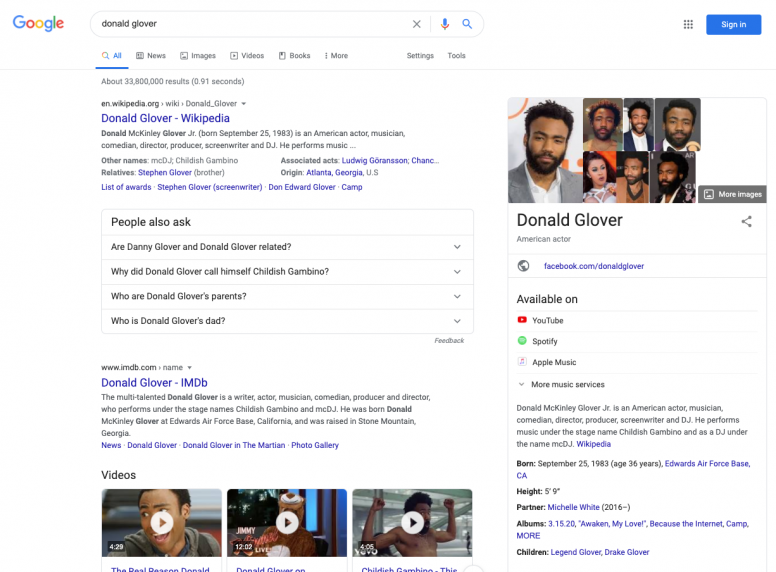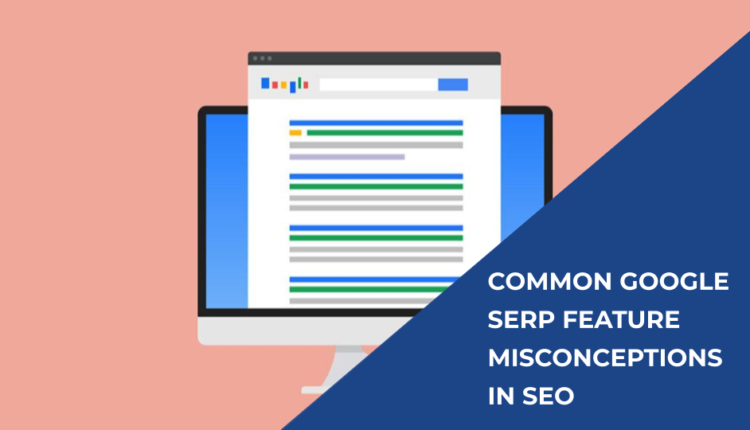6 Most Common SERP Feature Misconceptions
Learn all about the common SERP Feature Misunderstandings in this article
The world is developing all the time and is it easy for people working with SEO to fall behind when it comes to the latest SERP feature misunderstandings. SEO professionals need to be updated and constantly on their toes if they want the latest updates on the Internet.

We are in the year of 2021, where almost anything is possible. We are for example able to launch a rocket into space with great success, but apparently, we are not able to stop the increasing misunderstandings online.
In marketing, there has been a lot of things said and done, which might have been repeated a couple of times and now are qualified as misunderstandings; small things that we took in as an important matter to guide our SEO strategies once because everyone thought it was a great idea.
The misinformation about SEO that appeared might have been true at that time or maybe it was never true, especially not in the way that people think. Thus, SEO is more data-driven now you will still find silly beliefs within the field.
Let’s point out some of the SERP Features misunderstandings in this article.
Here’s a short assembly of the six most common misunderstandings about Google SERP Features which has been seen used on the Internet the last year including the reason why it is not good to use them.
What Are SERP Features?
Let us start defining what SERP is.
SERP is an abbreviation for the Search Engine Results Page and it refers to the place where we see our results after searching for keywords. A SERP contains organic results, paid results, and SERP features.
Here is an example of a SERP. If you want to know how Donald Glover looks like, you will go to Google and search for “donald glover” and the SERP will look like this:

In the picture above of a SERP, you will find both organic results and SERP features. SERP features are for example the “People also ask” setting, Videos, Sitelinks, and a knowledge panel on the right side of the picture.
Let’s learn more about the SERP features and take a closer look into the meaning of it. At first, it is good to know that “SERP feature” is actually an unofficial term. Google will call it names like “a type of results that is needed” or “something you want to learn more about”, for example, “search result features” or “rich results”.
The most confusing part is that Google is using different terms, which actually mean the same, to the individual search result features, For example, Google has named event SERP features an “enriched search result”, even though it is still categorized as an “interactive rich result.”
It is important to have that in mind when defining a SERP feature, which one ad an extra element on the SERP as something new to the typical format of a results page, which will be shown with a blue search result link and description.
Google will continue to try and improve all the special features they can, to give everyone the best user-friendly experience online.
In this article, the term “SERP feature” will be used instead of Google’s use of “search result feature” or “rich results” as it is more general.
Below you will find the most common SERP Features that you will see on the Google search engine:
- Featured Snippet (Instant Answer)
- Local Pack
- Reviews
- Sitelinks
- Videos
- Top Stories
- Images
- Knowledge Panel
- FAQs
- People Also Ask (Related Questions)
- Google Flights Block
- Hotel Pack
- Job Listings
Paid Results
- Google Ads
- Shopping Ads (Product Listing Ads)
Why Are SERP Features So Important
The purpose of SERP features is to give the users all the relevant information they need, meanwhile providing a great user experience. Take the Knowledge Graph as an example, which will give all the general information at just one look. In that way, the search results will help users understand the context within a few minutes.
SERP features will make it simpler for users to get just what they need, so it is possible for them to take the next step as soon as they can. If there is a user, who drives around town to find the right ice cream shop on the mobile device, Google will always help find the nearest and best ice cream. SERP features help you to get depth and context within the organic search results.

Six Common SERP Feature Misunderstandings
There is no doubt that you can find a lot of great information about SEO, including SERP features online. At the same time, you will also find quite a bit of unclear information, which can lead to misunderstandings or misconceptions of the SERP features.
Within SEO it is common that people sometimes get misinformation or have misunderstandings and misconceptions. This is just a small part due to Google being a huge box with all kinds of information, which is why people need to know what is right or wrong.
To eliminate all the misinformation when it comes to the SERP features, through this article you will learn more about six SERP feature misunderstandings and the reason why they are wrong.
1. FAQ and How-To Schema Results
The highest number of FAQ and How-To schema-rich results, which will show on the first page on Google, is three. It has been shown on both FAQ schema and How-To schema rich results on mobile and desktop search results. If there are less than three rich results that are suitable, the number will be filtered and adjusted.
People might think that there is “no limit” to the number of FAQ and How-To schema-rich results because it has been a way to get an answer for a long time. There are for example no limits on review snippets with Product schema when it comes to the amount that will appear at the same time on the Google results page.
Filtering is often seen when FAQ and How-To rich results do not appear. It is important to be conscious of all the limits, which can be a huge benefit when solving problems online.

2. Using Structured Data
You will not be able to have a lot of structured data on one single page. As there are no consequences from Google’s side on the extreme use of structured data, a good piece of advice will be that time is often spent better on other things. You should rather focus on what gives your website value.
Though there is one question when it comes down to the definition, which has caused a bit of confusion within SEO professionals. When looking at it from an SEO perspective, there will be no generic ranking system connected to the use of structured data. Thus, if you use the correct types of schema and handle it right you can actually provide a good amount of relevant results for online users. It is a good idea to remember what will and will not generate rich results on your website.
Everyone will not share the same opinion about structured data and why you should not spend a lot of time on a task that needs a significant investment of your time. If you are using WordPress there is already a great tool like “Yoast” that is able to help you solve a lot of the constant structured data problems which your site face. The plugins will provide Google with loads of structured data signals, and without you investing a huge amount of time on it.
3. Does Structured Data Have an Influence on Featured Snippets?
Structured data is not used to generate Featured Snippets on Google, but the construction of content on a site is, and regularly as a contributing element. Google decides whether the content is or is not appropriate for inclusion in Featured Snippets.
The misconception of structured data that is influencing Featured Snippets is something that often is an issue. It is often seen because of tests where structured data is being put into the page and then it is suddenly added to a Featured Snippet. It is difficult to make any sense of this connection even for professionals, which only shows the difficulties of how highly content is presented on the top rankings of Google’s search engines. However, Google has said a lot of times that structured data do not have an influence on Featured Snippets.
4. Scroll-to-text with Featured Snippets
Right now, scroll-to-text will only activate by Featured Snippets on Google within two different scenarios. The first is when the Chrome browser is used on both mobile and desktop. The second one is when using Accelerated Mobile Pages (AMP) makes an URL on a mobile device.
Although you don’t see this that often it still makes sense to create awareness about it. Highlights of Featured Snippets have been seen online since December of 2019. They were originally only for websites assembled with AMP.
Scroll-to-text has been a fascinating supplement when you need to search. There has been a gradual development as it was used through Chrome, on insights that sometimes appear on Google Search Console. Now it is also being visible beyond Featured Snippets on Knowledge Panels and weekly reviews in some free product catalogs.
5. Shopping Tab List
The unpaid listings that you will find on Google’s shopping tab are created completely on data submitted through product information in Merchant Center. Support was at first for both product information and structured data, but Google’s documentation was updated in 2020 and changed to only product information.
Google changed it in 2020 so that the product information and the structured data were used as a contribution to an unpaid Shopping tab list. It was presented as a small change in Google’s documentation but was included in the announcement as well, which confused a lot of people.
The latest announcement from Google changed the name from “surfaces across Google” to “free product listings”, which is nice to have in mind for the feature. If you are ever going to solve an issue related to “free product listings” on the Shopping tab, then I will rather recommend you to spend some time on research about Merchant Center data and not your product structured data.
6. Web Stories With Rich Results
Google’s Web Stories are a feature that is able to rank on mobile and desktop search, but the best results definitely come to life on mobile. With the AMP Test, it is possible to support Web Stories. You can now find your Web Story preview the most valuable results, which will show on all mobile devices.
When a Web Story appears in Google’s search results while using a desktop device, it can be a different and weird experience for the user. The result is selected and then thrown into the full-screen Web Story experience. It is not a good user experience on the desktop as the URL looks like a standard web search listing. It is a UX that Google still needs to adopt.
Web Stories are a really nice format thus, and it is worth investigating in as it is considered one of the better results that give you a strong benefit on mobile phones. Moreover, creating Web Stories make you stand out from the crowd and give you higher status on Google Discover.

Elevating Your Content with SERP Features
When it comes to design you should update all relevant websites via schema, which will help you structure your site including data and content, so search engines can easily use the information to serve the users on SERPs.
In the last couple of years, there have been examples of brands winning Featured Snippets without using schema, which might be because of Google’s algorithms growing really fast. So fast, that it is possible to scan, collect and serve information that is unstructured. As long as the web page is matched with search intent and has relevance. However, it is never a good idea to count on the bot to truly understand all of your content, so structuring your website will always be a great thing to do.
Getting into SERPs is a good way to make your website stand out and get rankings. With a great strategy, you will get more traffic to the website and convert users to customers.
Conclusion
There are a lot of misconceptions when it comes to SEO. Some of them used to be true but aren’t any longer, given the way the field has evolved. A few of them were never true – they just sounded good, so we believed them.
Succeeding at SEO is not about finding all popular theories or misinformation you’ve heard through gossip and not about jumping on the most popular advice you get.
This article has introduced you to the top areas of SERP feature misunderstandings, which were mostly related to structured data, Featured Snippets, free product listings, and Web Stories. If some of the SERP features got you a bit confused then you don’t need to worry, just use this as an opportunity to get a better understanding of what is correct and what is not.
Having a clear understanding of the areas in this article is great, then you can start to expand your Google SERP feature knowledge. SERP features changes all the time on Google, so you remember to keep yourself updated on the latest changes on Google’s documentation.
You are now inspired and empowered by the correct knowledge, so go ahead and create the value that users are looking for on Google Search Engines.

Comments are closed.